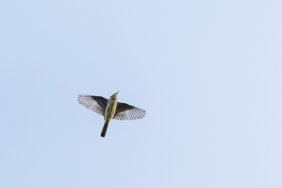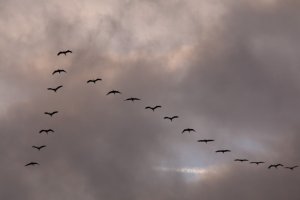Few natural phenomena capture the imagination quite like bird migration. True bird migration at our latitude occurs in spring, as birds navigate towards their often more northerly breeding grounds, and in autumn when birds return to their typically more southerly wintering areas.
Which species can i observe?
Autumn sees a greater number of migrating birds, as the season includes not only the adults but also their young. September and October represent the peak of the bird migration season. So pay attention during your bike commute to work: you might catch sight of birds migrating overhead.
Each species has its preferred time of year and time of day for migration. Early and common migratory species include swallows, yellow wagtails, and tree pipits, which are most visible in the first half of September. By late September, meadow pipits become more prominent, followed by chaffinches and reed buntings, with a few bramblings appearing later. In early October, you might also spot siskins and jays, although their numbers can vary significantly from year to year. By late October and into November, the sky is often filled with skylarks, starlings, and wood pigeons, and for the fortunate observer, there might even be a few days with cranes.
Bird migration intrigues us because it is often visible, yet unpredictable: there's an element of surprise. Even experienced birdwatchers may find themselves surprised by the presence or absence of migrating birds at various times and locations. Truthfully, bird migration remains only partially understood.
How do i recognize different species?
With a bit of effort, some of the species mentioned can be identified by their shape in flight. Swallows stand out with their forked tails, and yellow wagtails can be identified by their long tails.


Barn Swallow. Yellow wagtail.
Photo: Piet de Poorter, Westkapelle, april 2015 Photo: Jeroen Vreeken, Oeffeltermeent, september 2024
Starlings often form large, ball- or bullet-shaped flocks, while wood pigeons may migrate in extensive, horizontal flocks, sometimes comprising hundreds of birds. Cranes, like the more common geese, often form V-shaped formations. Distinguishing pipits, chaffinches, reed buntings, bramblings, and siskins can be more challenging due to their small size and undulating flight.


Cranes. Starlings.
Photo: Anne Kiwitz, Megchelen, maart 2024 Photo: Anne Margreet Hazekamp, Schiermonnikoog, augustus 2024
Despite this, it is often possible to identify these birds. They continuously make 'contact calls' in flight while migrating. These calls are distinctive and not too difficult to learn. Bird flocks may include a mix of species, so careful listening is necessary. The tree pipit’s call is a shrill, downward false note 'psee', while the meadow pipit’s call is a loud and short, onomatopeic 'peep', 'peep-it', or 'peep-peep-it', with each note ascending.
meadow pipit
tree pipit
Pipits are small birds with slightly long tails. Chaffinches, bramblings, and reed buntings have larger body masses, and chaffinches and bramblings may appear 'fat-chested' in flight. Their contact calls are unmistakable: the chaffinch call is a repeated 'djüp', with a bright 'peenk' also occasionally heard; the brambling's call is a doubled 'jack', sometimes accompanied by a nasal, distinctive 'èngh'; and the reed bunting has two common flight calls: a raspy, downward, almost bisyllabic 'gree' and a characteristic, complaining 'tseew'.
chaffinch
brambling
reed bunting
When is the best time to observe the birds?
These species dominate the skies during the early morning hours. However, bird migration encompasses a variety of patterns. Some species migrate at night and make contact calls in flight. Common nocturnal migrants include various geese and sometimes crane towards the end of autumn, while thrushes begin migrating as early as mid-September. They are easy to identify by their calls: the blackbird’s call is a high-pitched, drawn-out 'streee' at one pitch.
blackbird
Note that many blackbirds are migratory: most blackbirds that breed in our gardens are resident but some migrate to southern England, Spain and Portugal in winter. Another fun fact: in winter, our resident birds are augmented with birds that breed in Scandinavia. Yes, the blackbird is a thrush! The song thrush, also a common migrant thrush, has a thin, short 'pit' call. Pay attention or you will miss it!
song thrush
The most common migrant thrush is the redwing, whose call is similar to the blackbird’s but distinctly downward-inflected. It is common to hear a redwing every minute between 22:00 and 00:00 during the migration period.
redwing
Get to work!
We encourage you to just try from your garden; the location does not matter much as these birds migrate over an extremely broad front. Even in some mornings, thrushes may still pass by overhead. Listen to their calls using the provided examples above. Have fun!
Biodiversity at UT
Strengthening biodiversity on our campus is one of our sustainability goals at the University of Twente. By improving monitoring, we gain knowledge about biodiversity on campus in general, which helps us decide on the best ways to support it. In 2024, we started the yearly Bioblitz, in which anyone can help monitor species via the app ObsIdentify. Several activities were organised to raise awareness of biodiversity (such as bird observation). A biodiversity council was established, where CFM (Campus & Facility Management) consult with biodiversity enthusiasts on how maintenance can contribute to an improved habitat for species. Furthermore, thanks to a Climate Centre grant, we are working on making data on green maintenance and biodiversity accessible for research and education.
Would you like to find out more about sustainability at UT? Please go to utwente.nl/sustainability.





